Lead Seals and Ropemaking
Posted by Susan Kruse - 10:36 on 19 February 2018
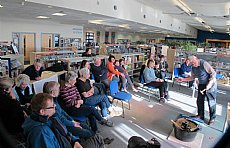 The February Experimental Archaeology brought us to the modern period. Taking its inspiration from stamped lead seals from Russia found in Cromarty, engraver Ian Hammond helped us explore the materials and manufacturing needed for these objects. The seals were fixed to bales of flax and then hemp in the latter 1700s and first half of the 1800s. Vast quantities were shipped to the UK from Russia,
The February Experimental Archaeology brought us to the modern period. Taking its inspiration from stamped lead seals from Russia found in Cromarty, engraver Ian Hammond helped us explore the materials and manufacturing needed for these objects. The seals were fixed to bales of flax and then hemp in the latter 1700s and first half of the 1800s. Vast quantities were shipped to the UK from Russia, 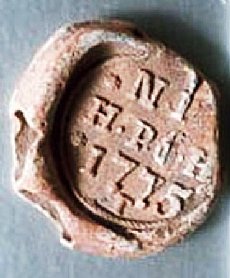 including to Cromarty, where spinners wove the flax into linen cloth, and the hemp into bags. A large building was built in Cromarty –the Manufactory – where this took place, and which still survives in part now converted to housing (see below)
including to Cromarty, where spinners wove the flax into linen cloth, and the hemp into bags. A large building was built in Cromarty –the Manufactory – where this took place, and which still survives in part now converted to housing (see below)
 Although both flax and hemp were grown in Scotland, there was not enough for the needs of an enterprise such as that in Cromarty, and as a result much was imported from the Baltic. The set up shows globalisation in action at this early date – hemp from Russia, made into bags which were then exported to London and then destined for the West Indies. The scale of the trade was huge: output from the Manufactory was valued around 1808 at £25,000 (Alston 2006, p. 165).
Although both flax and hemp were grown in Scotland, there was not enough for the needs of an enterprise such as that in Cromarty, and as a result much was imported from the Baltic. The set up shows globalisation in action at this early date – hemp from Russia, made into bags which were then exported to London and then destined for the West Indies. The scale of the trade was huge: output from the Manufactory was valued around 1808 at £25,000 (Alston 2006, p. 165).
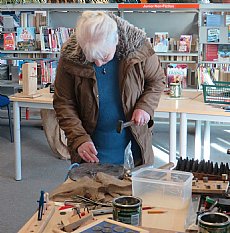 Ian took us through all the stages involved in the manufacturing of the lead seals and fixing them to the bales. First the blank dies needed to be engraved – and he showed us tools which had been in his family for three generations- and were contemporary with the seals! He argued from practical experience that the design could not have been pressed into the lead using large pliers, but instead were probably struck. So, in Dingwall Library he installed a portable pressing station.
Ian took us through all the stages involved in the manufacturing of the lead seals and fixing them to the bales. First the blank dies needed to be engraved – and he showed us tools which had been in his family for three generations- and were contemporary with the seals! He argued from practical experience that the design could not have been pressed into the lead using large pliers, but instead were probably struck. So, in Dingwall Library he installed a portable pressing station.
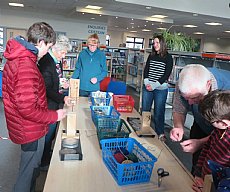 But before the blanks were pressed, cords would need to be threaded through two holes in the lead die. So we made some cordage, using a simple models of ropemaking machinery which Ian installed on tables. This proved great fun for young and old, and we made multi-coloured cords of various thickness.
But before the blanks were pressed, cords would need to be threaded through two holes in the lead die. So we made some cordage, using a simple models of ropemaking machinery which Ian installed on tables. This proved great fun for young and old, and we made multi-coloured cords of various thickness.
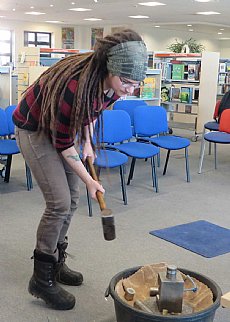 Once threaded into the blank, we then used Ian’s machine to choose a top and bottom design, with the blank placed in between. This was then hammered together (the high point of the day for some children), and then the seal was removed, ready to be taken home. As one participant said, it was a serious addictive process!
Once threaded into the blank, we then used Ian’s machine to choose a top and bottom design, with the blank placed in between. This was then hammered together (the high point of the day for some children), and then the seal was removed, ready to be taken home. As one participant said, it was a serious addictive process!
Lead seals which were affixed to finished cloth with rivets were also known in the U.K. from the medieval times onwards. Ian also showed how this was done, and some people punched their own designs – using the family punches, and fixed them to some rough burlap.
The Cromarty Manufactory also made rope from the imported hemp in the 1800s, as indeed was also done in Rosemarkie. Our small machines for making cordage would have been on the same principle for the ropemaking, with thicker and thicker strands intertwined. As Ian explained, it would also have involved one worker walking miles during the day. Rope was needed in vast quantities at this period, with rigging in sailing ships requiring huge quantities of rope.
As usual at these workshops, the presentation got everyone thinking and asking questions. Who would have made the seals? The Cromarty seals were made in Russia, but were seals also made in Scotland? Were they affixed to the finished linen products and bags made at Cromarty at the export stage, and if so, who would have produced them and where? Who would have produced the small machine for stamping the seals?
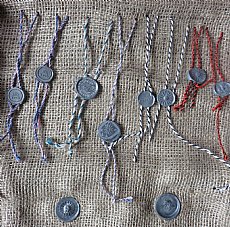 We were all struck by the huge preparation Ian had done for this workshop, and the fact that everyone could go home with objects created during the event was hugely appreciated. For the loans box Ian has produced a number of seals and cordage.
We were all struck by the huge preparation Ian had done for this workshop, and the fact that everyone could go home with objects created during the event was hugely appreciated. For the loans box Ian has produced a number of seals and cordage.
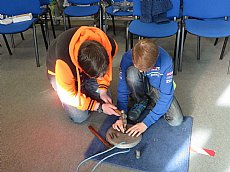 Further information:
Further information:
Over 100 lead seals have been found at Cromarty, cut off and thrown onto the midden and then spread on the fields. The Peacehavens website illustrates all that have been found so far, also published in John Sullivan’s book. Books by David Alston and Ian Mowat provide some of the context.
Peacehavens website
The website has background information on lead seals found in the U.K., and provides pictures and details of all the Cromarty seals.
Ian R.M. Mowat 1981. Easter Ross 1750-1850: the double frontier
David Alston 2006. My Little Town of Cromarty
John Sullivan 2012 . Russian Cloth Seals in Britain. (not in Highland Libraries, but available on interlibrary loan)
www.ukhemp.co.uk/articles/a-brief-history-of-hemp-in-the-uk
Information about the use of hemp in the UK.
Videos
There are a number of videos available showing ropemaking with large machinery, including:
Making rope using nineteenth century equipment at the Museum of East Anglian Life at Stowmarket in Suffolk. C. 1820 machinery.
2:40
Rope Making at Ryedale Folk MuseumRyedale Folk Museum
3:41
Credits:
Picture of lead seal from Cromarty from the Collection of Cromarty Courthouse Museum. Other photos from ARCH.
The Experimental Archaeology: Learning about technologies in the past project has been funded by Historic Environment Scotland and the Heritage Lottery Fund.
Add your comment below
- Recent Blog Articles
- Learning Resources
- Crafting Day October 2018
- Medieval Coinage Workshop
- Viking Ring-Money workshop
- Thomas Telford Workshop
- Monthly Blog Archive
- June 2018
- May 2018
- April 2018
- March 2018
- February 2018
- January 2018
- December 2017
- November 2017
